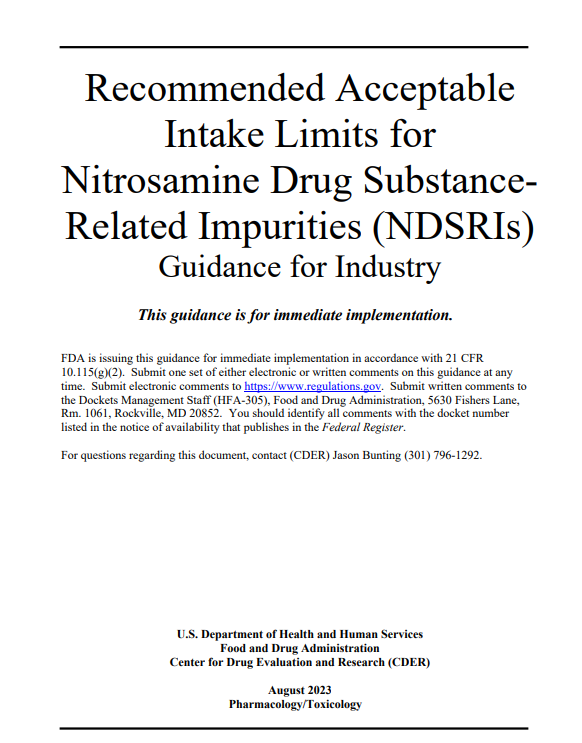The most expected document is out…
54486278fnl-Recommended AI Limits for Nitrosamine Drug Substance-Related Impurities_0.pdf (573.6 KB)
The most expected document is out…
54486278fnl-Recommended AI Limits for Nitrosamine Drug Substance-Related Impurities_0.pdf (573.6 KB)
Recommended Timeline for Implementing Risk Assessments, Confirmatory Testing, and Submission of Required Changes for NDSRIs
The most expected document is out…
@trust_user_a @Nitrosamines_Analyzer @trust_user_c @trust_user_d

I noticed the FDA and EMA category 1 limits still don’t align as Raphy had hoped they would correct!
Some things I noticed right off the bat about differences with other guidance documents which are important:
• FDA says to provide a “scientifically justified rationale” if the CPCA is not met. However, they lack the clarity HC and EMA had.
o No mention on what to do with a negative Ames. They mention the EAT protocol, but what do you do with a negative? EMA and HC says TTC is appropriate.
o No mention of what to do with a negative in vivo study. EMA and HC says apply ICH Q3A/B.
o The read-across recommended is more restrictive, only limiting to what seams like a handful of compounds with robust data. Although in practice, other Health Authorities seem to be using a similar approach.
• Category 1 is 26.5 ng/day versus 18 ng/day (not particularly impactful but good to know)
To be honest, I would like to see all NDSRIs defaulted to 100 ng/day.
Sir 10%-30% criteria not given in this guidelines as per EMA guidance
I think is just different opinions within agencies and FDA already worked on the 26,5 basis from the very beggining. Nevertheless, pragmatically speaking 26.5 is higher but being 18 ng/day or 26.5 ng/day for Category 1 is still to low for NDSRIs.
Thanks Naiffer!
Just to complement the info, in this link is indicated the limits for several NDSRIs (similar to EMAs appendix 1).
Your insights are greatly appreciated, @jbercu. Despite certain differing viewpoints among regulators, it remains crucial to acknowledge the areas of agreement and the harmonization that is being forged. Moreover, reflecting on the progress made over the past five years, it’s evident that significant advancements have taken place, with undoubtedly more to come.
Now no confusion of limit for EMA and US.
Is it just me?..

On this specifically, it can’t be the only compounds, given that read-across to NTHP is used for nitrosovarenicline and the sitagliptin impurity by the FDA, and while NDEA isn’t in this list because 26.5 is the effective floor, it must also be considered robust. My approach for these will be ideally to demonstrate that my chosen analogue has data at least as robust as that for a compound in the provided list (or NTHP) - or if not to point out this discrepancy and argue the sufficiency based on the suitability of the study for the purpose I need to put it; e.g. as part of a weight of evidence and the development of the CPCA the studies cited as relative potency information in Rao et al, some of which don’t even have a Lhasa TD50, have been considered as useful!
按照FDA的CPCA,N-nitroso-vonoprazan的AI应该是按照26.5ng,与之前批准的96ng不一致,在这种情况下,N-nitroso-vonoprazan的AI会按照26.5ng还是96ng?
Finally , FDA has come up with a guidance. This gives at least some way froward to industry. Hope to see further updates and revisions on the same.
Great news by USFDA, Thanks for publishing and sharing Guidance.
I uploaded the AI list of NDSRIs by FDA.
NDSRIs list in FDA2.pdf (368.2 KB)
And I compared AI list between FDA and EMA, and found the difference of AI for N-nitroso-atomexetine.
N-nitroso-atomexetine: EMA:100(read across), FDA: 26.5(Category 1)
NDSRIs included in the list differ significantly between FDA and EMA.
Section II stipulates: This guidance also applies to prescription and OTC drug products in clinical development
Does this apply to all Phase 1-3 investigational medicines that are not for S9 patient populations?
FDA’s “Control of Nitrosamine Impurities in Human Drugs” applies to marketing applicants and existing market authorization holders, so it seems the two documents do not align. How are you all interpreting this?
Naiffer, the guidance did not cover:
If more than one NDSRI present in the same drug, what is the limit for total NDSRIs?, same old NSA rule applied?
If morethan one Nitrosamine present, and while reporting total nitrosamines, should this NDSRIs combined with other NSA(small molecules, example NDMA etc.,) ,
All the AI limits published for NDSRIs are majorly drug related, what about impurity-NDSRIs?, where similar -NH- moiety present the impurities. Manufacturers should also consider impurity-NDSRIs? while risk assessment, followed by confirmatory testing?
Subject matter experts in the group can throw some light on the questions for better understanding.
Page 18 seems clear that a risk assessment and confirmatory testing are expected with the application, but may follow after. I don’t see any expectations while in the clinical trials themselves.